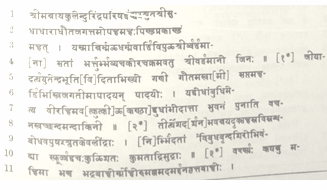|
The Indian Analyst
|
North Indian Inscriptions |
SRAVANA-BELGOLA EPITAPH OF MALLISHENA. least we have hitherto found the title only within the current millenary. Among the Śvêtâmbaras it is borne by several members of the Harshapurîya-gachchha. Later on there appears a separate Maladhâri-gachchha, which must be derived from some eminent Śvêtâmbara, named Maladhârin ; e.g. two representatives of this gachchha, Guṇatilaka and Kshamâsundara, are quoted in Samayasundara’s Sâmâchârî-śataka. The earliest mention of a Maladhârin would be found among the Digambaras, if the date Śaka-Saṁvat 975 for Maladhâri-Hêmachandra (Mr. Rice’s Inscriptions at Śravaṇa-Beḷgoḷa, No. 55, pp. 49, 50, 141, and p. 37 of the Introduction) is correct. In the eleventh century of the Śaka era, several Digambaras of the name Maladhâridêva appear to have lived at Śravaṇa-Beḷgoḷa. One is mentioned in the Hampe inscription discovered by Mr. Sewell ; and Mr. Rice’s book refer to one who was a pupil of Divâkaranandi and preceptor of Śubhachandradêva (Śaka-Saṁvat 1041 ; l c. No. 139, pp. 110 and 185), another in Śaka-Saṁvat 1099 (No. 42, pp. 13 and 123) who was a pupil of Dâmanandin (Śaka-Saṁvat 1040 ?), and a third in Śaka-Saṁvat 1045 (No. 43, pp. 17 and 124).
......[There is a Digambara author called Mallishêṇâchârya, three of whose works are named in Mr. Rice’s Skt. MSS. in Mysore and Coorg,─ the Nâgakumâra-kâvya (p. 302), the Prâbhṛitakatraya-vyâkhyâna (p. 310), and the Mantravâda (p. 316). This author might be considered distinct from the Mallishêṇa of the inscription, which does not refer to any literary product of the latter. An argumentum ex silentio is, however, out of place here ; for Mallinâtha, the composer if the inscription, appears to have been a professional panegyrist, who knew little of the ecclesiastical tradition and might have easily overlooked eventual works of Mallishêṇa on theological matters.] ......[I have derived the above information on Maladhârin and Mallishêṇa from Dr. Klatt’s Jaina-Onomasticon, a book which contains an enormous amount of references, but requires through revision and condensation before it can be presented to the public. Only a specimen of the work was especially prepared for the press and printed in the Transactions of the Berlin Academy for 1892 (14 pages, 4°).─ E.L.] TEXT.1
......1 From inked estampages prepared by Mr. H. Krishna Sastri.
| ||||||||||||||||||||||||||||||||||||||||||||||||||||||||||||||||||||||||||||
| > |
|
>
|








